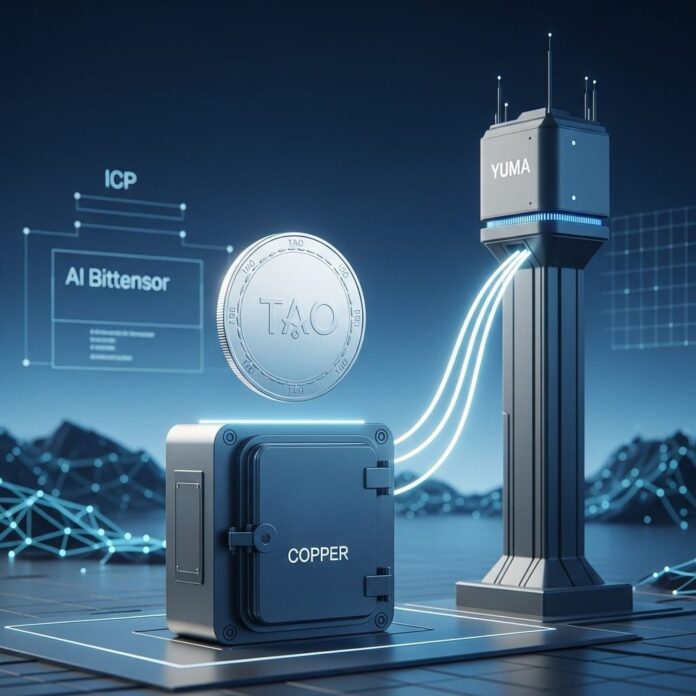Copper has teamed up with validator Yuma to offer institutional access to Bittensor staking, giving clients a smoother route to earning rewards from TAO—without skimping on security. The partnership brings together Copper’s experience in custody and collateral infrastructure with Yuma’s validator setup, tailored specifically for institutional use.
The update means that institutions using Copper can now stake TAO directly through the platform, aided by the technical integration of Yuma’s validator and Copper’s multi-party computation (MPC) tech. For those handling high volumes and compliance requirements, that’s a notable shift. It’s now possible to interact with the Bittensor network while still operating within a protected and well-audited custody environment.
Copper’s director of strategic alliances, Ben Lorente, says the goal is to make institutional involvement in TAO more straightforward. By partnering with Yuma, Copper clients now have a route into Bittensor’s incentive layer without the complications of handling infrastructure themselves. The message is clear: it should be easy to stake, and even easier to stay protected while doing so.
On Yuma’s side, the sentiment is just as focused. Evan Malanga, chief revenue officer, says the validator was built with this sort of integration in mind. The architecture behind it prioritises uptime, isolation, and trust—key concerns for institutions exploring the staking space. The firm, part of the DCG family, has been designing its validator setup to meet higher operational standards, including around custody interoperability, which is now paying off with this new connection to Copper.
What sets the arrangement apart isn’t simply access to staking—it’s the way it’s structured to avoid risks that typically accompany new asset interactions. With Copper’s infrastructure in play, the risks tied to self-hosted wallets, private key exposure, or delays between exchanges and custodians are softened. The partnership leans on ClearLoop, Copper’s settlement layer, which lets clients manage assets across multiple venues while retaining full custody.
For many institutions still navigating the cautious road into digital assets, this kind of setup offers some reassurance. While staking has long been seen as a logical next step after custody, the transition from holding an asset to actively participating in a network hasn’t always been smooth. Infrastructure gaps, security concerns, and regulatory scrutiny have kept some institutions watching from the sidelines.
This partnership aims to lower those barriers. Yuma’s validator operates with siloed architecture, meaning it can isolate client activity in ways that reduce exposure and improve reliability. Combined with 24/7 uptime and ongoing performance monitoring, it offers the sort of operational confidence institutions typically require. Copper’s role is to wrap that capability into a user experience that meets client expectations—secure, auditable, and capital-efficient.
The news comes as Bittensor’s TAO continues to draw attention from participants interested in decentralised machine learning and the value layer built around it. The network incentivises participation in AI activity and knowledge sharing, offering TAO rewards in return. For institutions already eyeing exposure to digital assets with longer-term potential, this provides a compelling reason to engage.
Though staking services through Copper are not available to clients based in the UK, the platform’s international client base still stands to benefit. The service is targeted at funds, asset managers, and corporate clients with a mandate to earn yield or rewards from held assets while maintaining a strong operational compliance framework. With staking rewards integrated into Copper’s platform, clients are spared the headache of cobbling together third-party systems or managing multiple dashboards.
The integration also avoids one of the recurring problems in digital asset infrastructure—fragmentation. With so many services requiring separate wallets, permissions, or manual transfers, institutions are often left juggling tools that weren’t designed to work together. The Yuma–Copper model offers a more cohesive experience, where custody, validator access, and settlement exist within the same ecosystem.
ClearLoop, Copper’s underlying network, plays a central role in this. Designed to eliminate the need to pre-fund exchanges, it allows users to lock up collateral while maintaining control of assets. That same principle now extends to staking, enabling rewards to be earned without assets leaving custody. It’s a tidy solution for clients focused on reducing counterparty risk while staying active in the digital asset landscape.
Copper has consistently positioned itself as a platform that combines security and access. From its earliest products around MPC custody to more recent expansions into prime services and DeFi pathways, the company’s focus has remained on simplifying institutional workflows without compromising on protection.
The move to support staking directly from its infrastructure signals a broadening of that mission. It’s no longer just about holding assets—it’s about putting them to work in a controlled environment. And with more protocols offering yield or participation incentives, that’s becoming increasingly important to a wide range of professional investors.
Yuma’s validator, meanwhile, reflects a new wave of infrastructure providers who are thinking beyond uptime and performance. By building for integrations like this one, the team at Yuma is hoping to support a wider base of institutional clients who expect audit trails, data transparency, and reduced operational complexity as standard.
The connection between staking and storage has always been a little tenuous. What this partnership does is stitch them together more closely. By allowing clients to stake directly from the same platform they use for custody, Copper eliminates friction and creates a use path that feels much closer to traditional asset operations—just in a digital wrapper.
The rise of institutional interest in staking coincides with changing attitudes toward network participation. What was once seen as technical or risky is now increasingly being packaged into products and services designed to meet institutional expectations. That doesn’t mean it’s simple—but it’s no longer inaccessible.
Yuma and Copper have chosen to go public with the partnership before any major product campaigns or token-based incentives, which signals a steady approach. It’s about infrastructure first, and growth through usage rather than noise. The institutions being targeted are more interested in reliability and risk profiles than brand marketing, and the communication reflects that.
This type of low-key rollout may serve as a blueprint for similar integrations in the future. With more protocols aiming to attract institutional staking, the need for secure, seamless validators connected to custody platforms will only grow. Partnerships like this one offer a glimpse of how the digital asset ecosystem might begin to standardise over time—especially where larger investors are involved.
For now, the message from Copper and Yuma is simple: staking doesn’t have to be complicated. With the right setup, institutions can participate in networks like Bittensor while maintaining high standards for protection, transparency, and capital efficiency. And with TAO now available directly on Copper’s platform, the door to that kind of participation has quietly swung open.
Dear Reader,
Ledger Life is an independent platform dedicated to covering the Internet Computer (ICP) ecosystem and beyond. We focus on real stories, builder updates, project launches, and the quiet innovations that often get missed.
We’re not backed by sponsors. We rely on readers like you.
If you find value in what we publish—whether it’s deep dives into dApps, explainers on decentralised tech, or just keeping track of what’s moving in Web3—please consider making a donation. It helps us cover costs, stay consistent, and remain truly independent.
Your support goes a long way.
🧠 ICP Principal: ins6i-d53ug-zxmgh-qvum3-r3pvl-ufcvu-bdyon-ovzdy-d26k3-lgq2v-3qe
🧾 ICP Address: f8deb966878f8b83204b251d5d799e0345ea72b8e62e8cf9da8d8830e1b3b05f
🪙 BTC Wallet: bc1pp5kuez9r2atdmrp4jmu6fxersny4uhnaxyrxau4dg7365je8sy2q9zff6p
Every contribution helps keep the lights on, the stories flowing, and the crypto clutter out.
Thank you for reading, sharing, and being part of this experiment in decentralised media.
—Team Ledger Life


